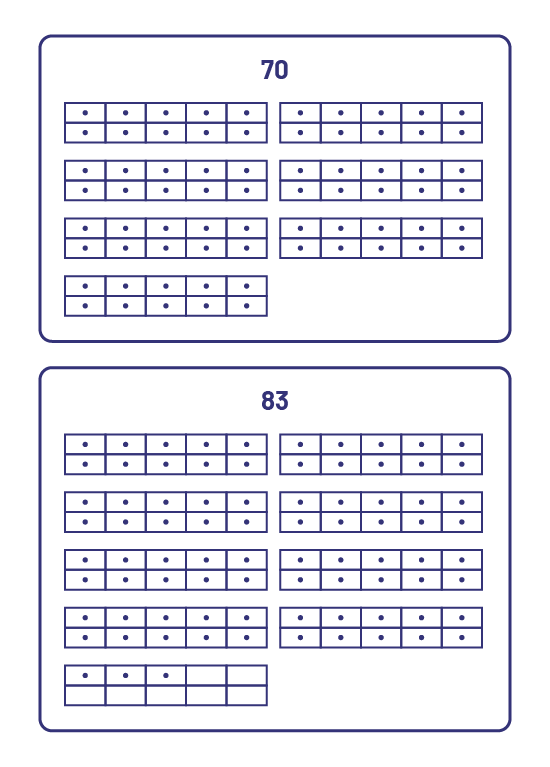B1.4 Count to 200, including by 20s, 25s, and 50s, using a variety of tools and strategies.
Activity 1: Go Fishing! (Counting)
Directions
Make decks of number cards from 70 to 110 (two decks per team) representing quantities using ten frames or base ten materials.
Group students into teams of three.
Give five cards to each student and place the rest of the deck face down on the table.
Explain to students the rules of the game:
- Team members take turns selecting one of their cards and asking the others on the team if they have the same one.
- If so, the member receives that card to form a pair and places both cards face up on the table. If not, they pick a card from the top of the deck.
- The next player goes and play continues until one team member has no more cards.
When the game is over, ask students to place the pairs of cards from the entire team in ascending or descending order.
Example of cards

Circulate around the classroom and ask students the following questions:
- Name all your number pairs.
- Which number comes just before or after this pair (point to the pair)?
- Name your pairs of numbers in ascending order, descending order.
- How many ten frames and five frames are needed to represent this pair (point to the pair)?
Source: translated from Guide d’enseignement efficace des mathématiques de la 1re à la 3e année, Numération et sens du nombre, p. 20.
Activity 2: Get 10! (Counting, Linking Sequences and Their Symbols)
Directions
Group students into teams of four.
Give each student a blank number chart and, to the team, a copy of a number chart and number cards from 1 to 200.
Tell students to take turns drawing a card at random, saying the number aloud and writing it on their blank number chart in the appropriate place.
Invite students to continue the activity until 10 consecutive numbers counted by 1 or in intervals of 2, 5, or 10 are written on one team member's number chart (for example, 23, 24, 25, …, 32 or 50, 55, 60,…, 95).
Ask students to check the number chart handout to see if the numbers are in the correct place on their blank number chart.
Teacher Moves
Circulate around the classroom and ask students questions such as:
- If the starting number is 27 (point to the number 27 on the chart), what would be the five consecutive numbers counting by 1? by 2? by 5? by 10?
- What are these numbers in descending order?
- Describe the rule in this sequence of numbers.
- Make a list of the numbers from all of your charts and put them in order from the smallest number written to the largest number.
Source: translated from Guide d’enseignement efficace des mathématiques de la 1re à la 3e année, Numération et sens du nombre, p. 21.
